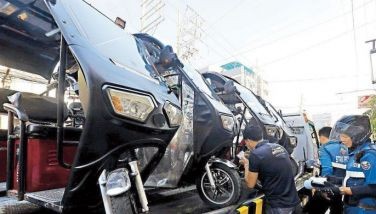‘2.3 million students still in dark ages’

MANILA, Philippines — At least 10 percent of the country’s students – about 2.3 million learners – remain in the “dark ages,” living in communities without electricity, which prevents them from distance learning using gadgets that run on power, Senate President Pro-Tempore Ralph Recto said yesterday.
The plight of millions of students emerged in the course of Recto’s separate questioning of the proposed 2021 budgets of the Departments of Education (DepEd) and of Energy (DOE).
Asked how many households still do not have electricity, Sen. Sherwin Gatchalian, defender of DOE’s proposed budget, replied: “2.3 million households.”
Recto said the figure translates to 10 percent of the population, “and these are usually large families with many children,” which means the number of students affected could be much higher.
That ratio, he explained, can be applied on school enrollment, “that it is safe to say that 10 percent of our DepEd enrollees are from homes without light or power… and are struggling under a new normal of education in which laptops and computers play an important role.”
“Before the pandemic struck, we already had millions of unplugged children, not by choice, but by circumstance,” Recto said. “If you don’t have electricity, how can you watch lessons on TV, or receive assignments via email?”
DepEd data showed that not only learners are hobbled by lack of power in their homes, but schools as well, as reflected in the agency’s drive to connect 449 “Last Mile Schools” in far-flung areas to power grids.
DepEd said it needs P3.85 billion to “power up” these schools, while the DOE said an aggressive sitio electrification program would require P25 billion to erase the backlog of 2.3 million household connections.
Recto said homes without electricity can also be found in an urban setting, where families are too poor to connect to and pay for billed electricity.
He proposed that variances in the budgetary allocations to state universities and colleges (SUCs) be lessened as rough calculations show that they share more or less equal burden of spending P80,000 per student a year.
He said that in the interest of transparency, a per-student cost should be made part of an SUC’s budget submission and a national comparative table included in the National Expenditure Program.
“This is not to pass judgment on whether certain schools deserve what they get, as there are metrics to be used other than a simple spreadsheet. Not all SUC students are funded equally. Each may have different requirements, such as equipment backlog or staffing deficit which must be erased, the investments for which would differ from school to school,” Recto said.
But what is clear, he said, is that the allocation should be rationalized and needs reworking based on updated and fair parameters.
“As we increase funding for state colleges, solidarity dictates that a rising tide must raise all ships,” Recto said.
- Latest
- Trending


























